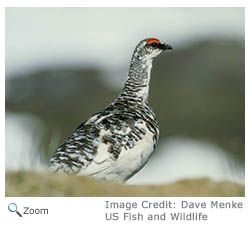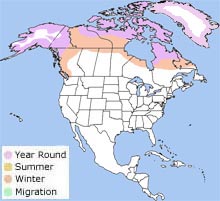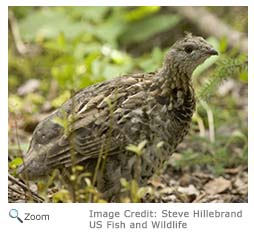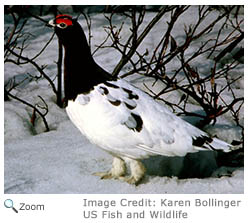Characteristics  The rock ptarmigan is a chicken-like bird about 11-16 inches in length. It has a square tail and a small black bill. It has feathered legs and toes that help it walk in the snow and help keep it warm. The rock ptarmigan is a chicken-like bird about 11-16 inches in length. It has a square tail and a small black bill. It has feathered legs and toes that help it walk in the snow and help keep it warm.
 In summer males have a whitish belly and wings and are speckled brown and gray on their backs. Females have speckled brown and gray plumage on all of their bodies. Males have a red comb over their eyes. In winter it is all white, except for a black tipped tail and a black line across its eyes. In summer males have a whitish belly and wings and are speckled brown and gray on their backs. Females have speckled brown and gray plumage on all of their bodies. Males have a red comb over their eyes. In winter it is all white, except for a black tipped tail and a black line across its eyes.
Range
 The range of the rock ptarmigan is circumpolar. Its territory spreads in a circle around the arctic. In North America it can be found in Alaska and northern Canada. It is also found in Scandinavia, Russia, Finland, Greenland. The range of the rock ptarmigan is circumpolar. Its territory spreads in a circle around the arctic. In North America it can be found in Alaska and northern Canada. It is also found in Scandinavia, Russia, Finland, Greenland.
Habitat
The rock ptarmigan live in upland tundras with thickets, willows and heath and in alpine areas.
|
|
Diet
Adult rock ptarmigans eat a variety of plant parts including berries, buds and twigs. They may also eat some insects.
Life Cycle  Males will select a breeding territory and protect it from other males. Males protect their territory with aerial displays, chases and calls. They will leap into the air and flap their wings, fly straight up, fan out his tail and glide back to the ground. During courtship, the male will drag one wing on the ground, fan out his tail, raise his red comb and circle the female. The female lays six to ten eggs in a sheltered hollow lined with grass and moss. The male and female will stay together until incubation reaches the halfway mark, then the male will leave. The chick hatch after 21-24 days. The female raises the chicks, who are walking around the tundra searching for insects to eat a day after birth. They fledge when they are 10-12 days old and are fully independent at about three months. Males will select a breeding territory and protect it from other males. Males protect their territory with aerial displays, chases and calls. They will leap into the air and flap their wings, fly straight up, fan out his tail and glide back to the ground. During courtship, the male will drag one wing on the ground, fan out his tail, raise his red comb and circle the female. The female lays six to ten eggs in a sheltered hollow lined with grass and moss. The male and female will stay together until incubation reaches the halfway mark, then the male will leave. The chick hatch after 21-24 days. The female raises the chicks, who are walking around the tundra searching for insects to eat a day after birth. They fledge when they are 10-12 days old and are fully independent at about three months.
Behavior
 Rock ptarmigan don't leave the tundra in winter, but they may migrate short distances to lowland areas in search of food. In the winter males and females live in separate groups. Rock ptarmigan don't leave the tundra in winter, but they may migrate short distances to lowland areas in search of food. In the winter males and females live in separate groups.
|